Hidden in scattered pockets across the state, amethyst in Missouri appears where time and mineral-rich water worked together deep underground. Its purple crystals rest quietly until erosion brings them close enough to catch the light.
Finding them takes focus and patience more than luck. Once your eyes adjust to the subtle gleam of quartz among dull stones, the search becomes second nature.
A little guidance can change the entire experience. When you know where to start, it’s possible to bring home amethyst crystals you discovered yourself!
What is Missouri Amethyst?
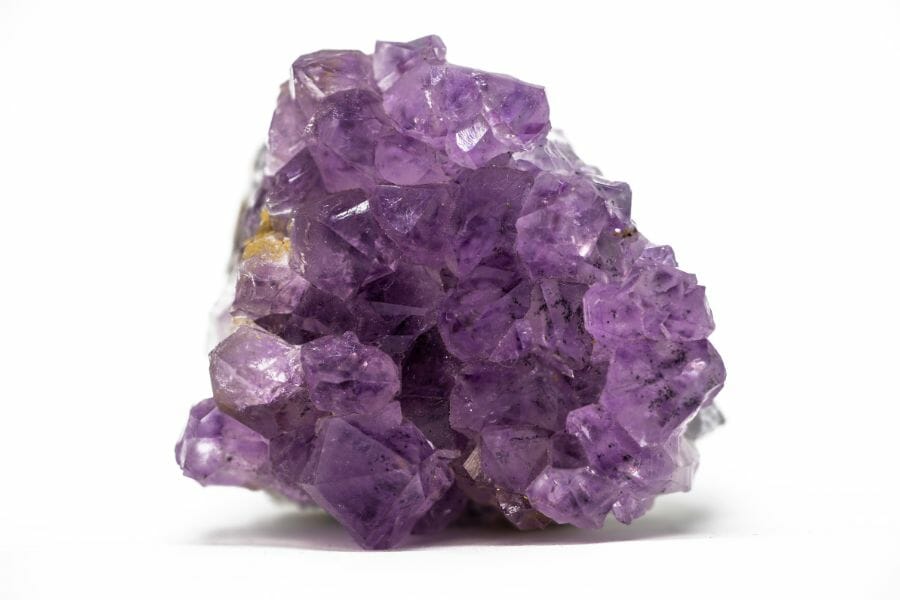
Amethyst, a stunning variety of quartz, is highly sought after for its captivating purple hues. For centuries, this remarkable gemstone has been admired for its beauty and its reputed spiritual and healing properties. Many believe that amethyst can calm the mind and bring balance to their lives.
Typically found in volcanic rocks and geodes, amethyst is commonly discovered in specific locations across the globe. Notable states, like Arizona and North Carolina, are recognized in the United States for their impressive amethyst clusters. Missouri also offers opportunities for amethyst hunting, although discovering these gems requires in-depth knowledge of the area.
When embarking on an amethyst-hunting adventure, keep these locations in mind. With some exploration and perseverance, you might uncover a spectacular gemstone that leaves a lasting impression.
The Different Types Of Amethyst And What They Look Like
Amethyst is a kind of quartz that forms in various geological settings, such as within volcanic rocks or in cavities of granites. These different environments contribute to the diverse appearances and types of this beautiful mineral.
The variety seen in amethyst is due to trace elements and impurities within the crystal structure. Elements like iron and manganese can alter the hue, leading to the beautiful spectrum of purples and other colors found in these crystals.
Brandberg Amethyst
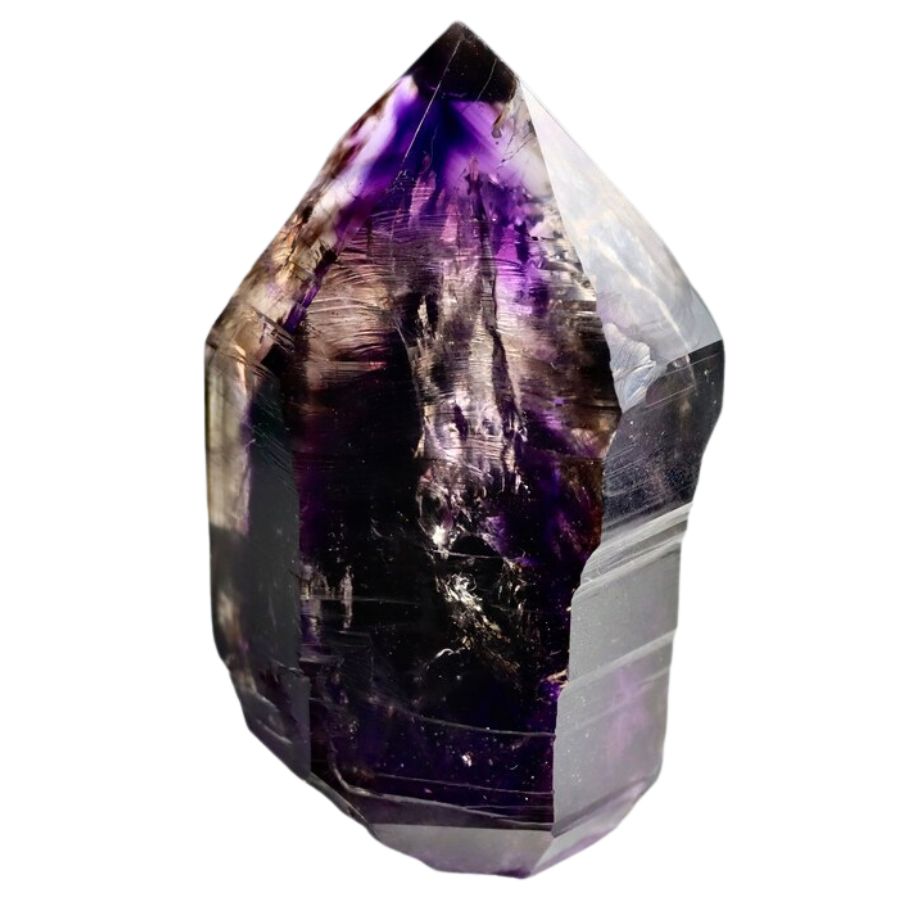
Brandberg amethyst is a captivating variety of quartz, renowned for its unique blend of elements like silicon dioxide, iron, and trace amounts of other minerals.
These components come together to form a crystal that not only holds geological significance but also showcases a striking array of hues and features.
The appearance of Brandberg amethyst is truly remarkable, characterized by its color range from deep purples to vibrant lilacs.
The varying shades are a result of the iron content within the crystal structure, which can fluctuate, leading to diverse color intensities and patterns in each specimen.
Brandberg amethyst stands out for its inclusion patterns and the presence of phantom crystals within its structure.
These internal “ghosts” are formed by layers of other minerals, offering a glimpse into the crystal’s growth history and adding to its allure for those fascinated by the wonders of the natural world.
If you want REAL results finding incredible rocks and minerals you need one of these 👇👇👇
Finding the coolest rocks in isn’t luck, it's knowing what to look for. Thousands of your fellow rock hunters are already carrying Rock Chasing field guides. Maybe it's time you joined the community.
Lightweight, mud-proof, and packed with clear photos, it’s become the go-to tool for anyone interested discovering what’s hidden under our red dirt and what they've already found.
Join them, and make your next rockhounding trip actually pay off.
What makes it different:
- 📍 Find and identify 140 incredible crystals, rocks, gemstones, minerals, and geodes across the USA
- 🚙 Field-tested across America's rivers, ranchlands, mountains, and roadcuts
- 📘 Heavy duty laminated pages resist dust, sweat, and water
- 🧠 Zero fluff — just clear visuals and straight-to-the-point info
- ⭐ Rated 4.8★ by real collectors who actually use it in the field
Ametrine
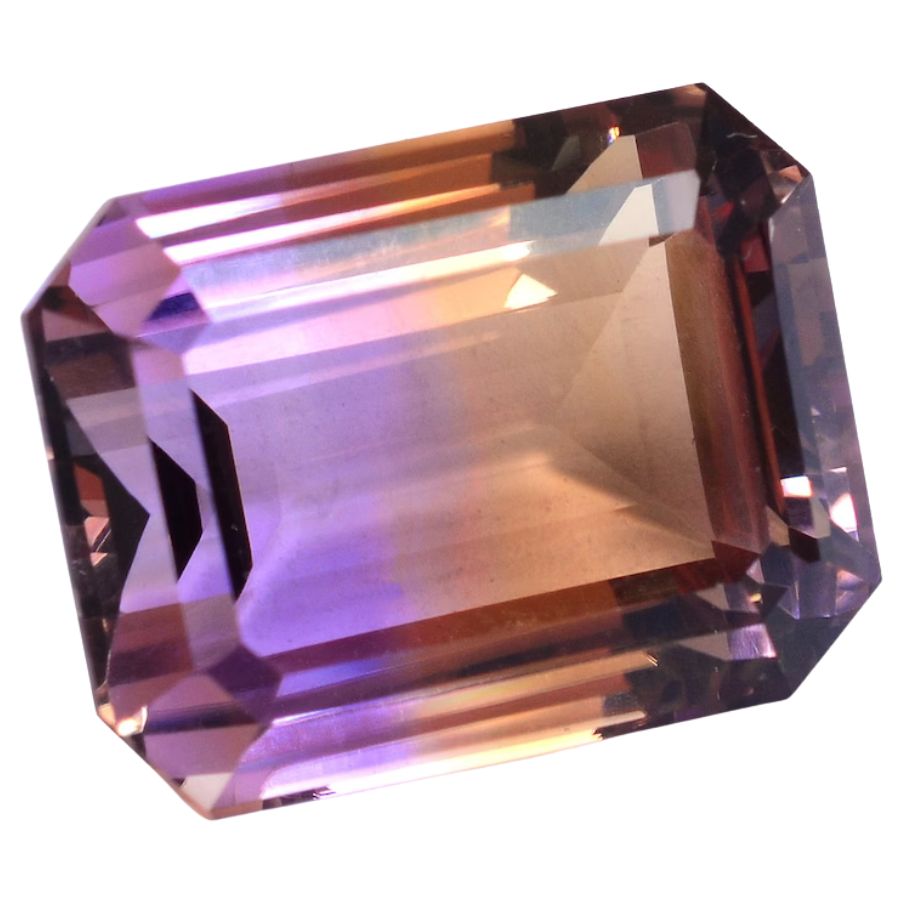
Ametrine is an intriguing mineral that captures the imagination of those interested in rocks and minerals. This unique gem is a combination of two quartz varieties: amethyst and citrine.
The beauty of ametrine lies in its striking coloration, which ranges from a blend of vibrant purple and golden yellow.
This color variation is a result of differing oxidation states of iron within the crystal, influenced by temperature and radiation exposure during formation.
Ametrine is notable for its distinct zoning of colors, where purple and yellow hues can be clearly seen in the same crystal. This feature, combined with its unique composition, sets ametrine apart from different kinds of amethyst.
Chevron Amethyst
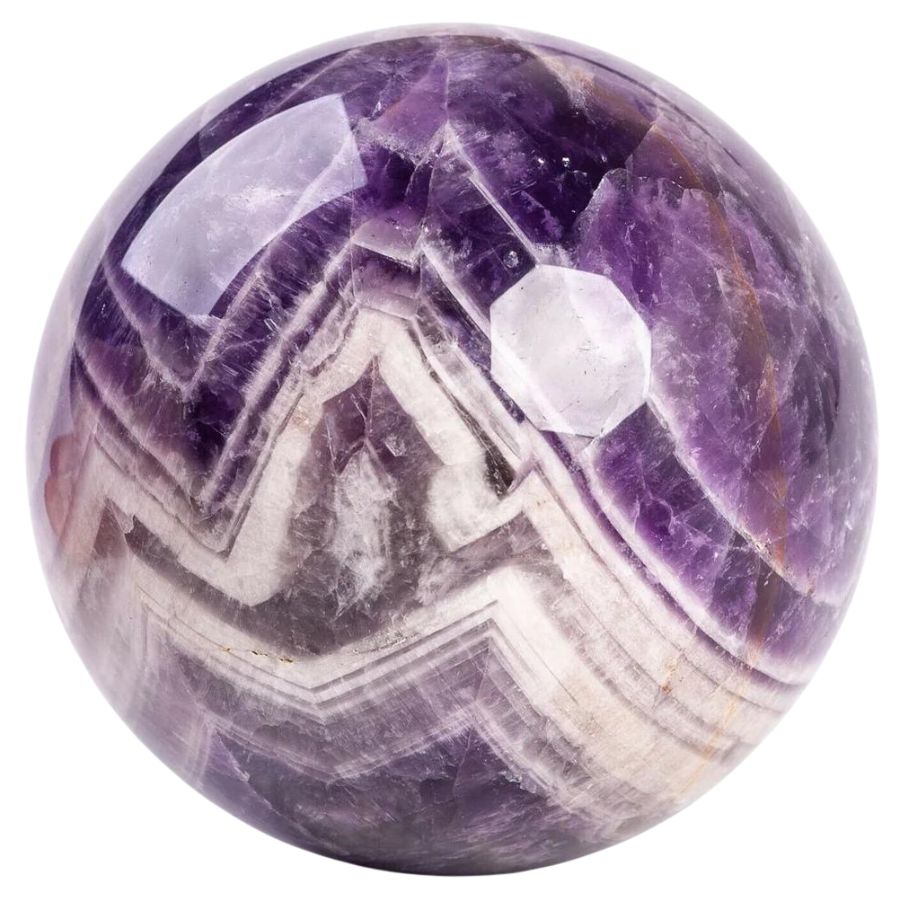
Chevron amethyst is a captivating type of amethyst known for its distinctive pattern. It’s easily recognized by its unique V-shaped or chevron patterns, which are a combination of deep purple and white or clear quartz layers.
These patterns and color variations are due to differences in iron content and other impurities in the layers, resulting in the striking contrast seen in chevron amethyst.
Chevron amethyst is not only beautiful but also a subject of interest for its formation process. The alternating layers of colors provide a visual record of the crystal’s growth history, making it a fascinating example for geological study.
Auralite
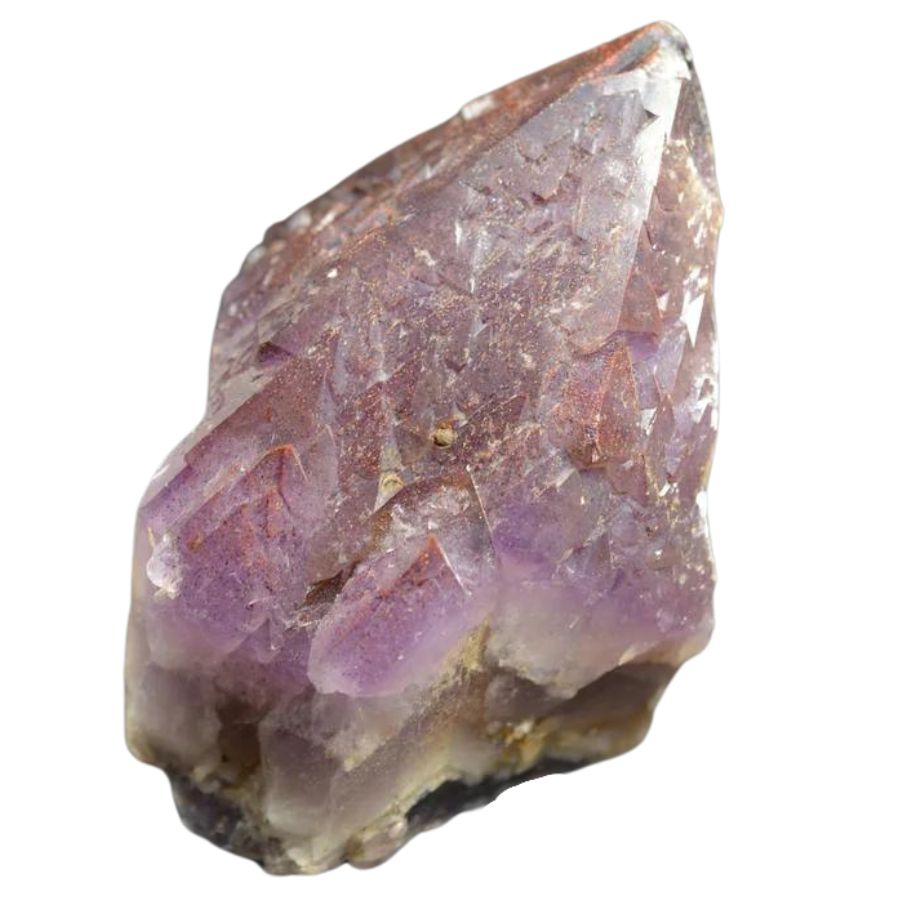
Auralite is an intriguing type of mineral that’s a combination of amethyst and several other trace minerals. Its composition includes silicon dioxide from amethyst, along with a mixture of elements like iron, copper, and titanium.
This mineral’s appearance is quite distinct, often showing a deep purple hue similar to what amethyst looks like, but with additional layers or inclusions of other colors.
These variations in color are due to the various trace minerals present in auralite, each contributing to its unique and colorful display.
A standout feature of auralite is the presence of multiple minerals within a single specimen, sometimes including up to 23 different types.
This mix not only gives auralite its diverse color range but also makes it a fascinating subject for those studying minerals and their properties.
Prasiolite
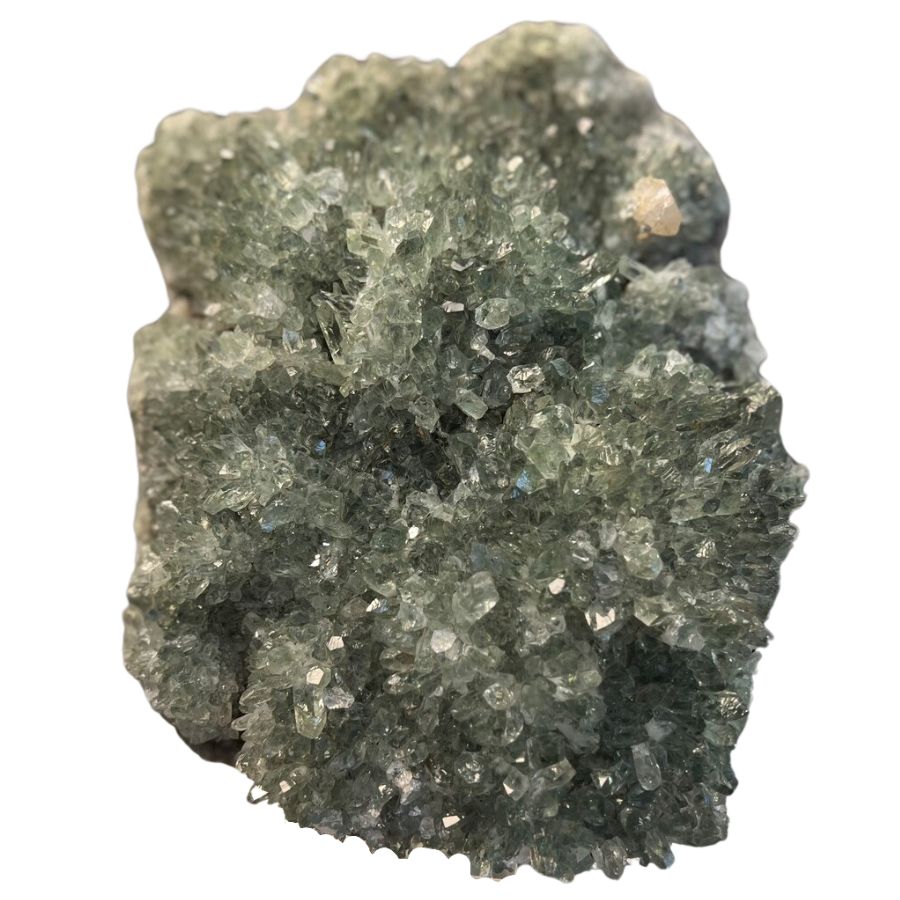
Prasiolite is an interesting variety of quartz. It often contains traces of iron, which play a key role in giving prasiolite its unique color.
This mineral is known for its beautiful green color, which can range from a light, almost transparent green to a deeper, more olive shade.
The green color of prasiolite is usually the result of heat treatment, either occurring naturally in the earth or artificially, transforming certain types of amethyst or yellowish quartz into prasiolite.
Naturally-occurring prasiolite is rare, as most available prasiolite is created through artificial means.
Cacoxenite amethyst

Cacoxenite is an intriguing mineral primarily composed of iron, aluminum, and phosphate, along with other elements like oxygen and hydrogen. This combination of elements gives cacoxenite its unique chemical makeup and properties.
Cacoxenite typically exhibits a striking golden-yellow to brownish-yellow color. This coloration is mainly due to the presence of iron in its structure, which imparts the rich hues that characterize this mineral.
A notable feature of cacoxenite is that it often forms as an inclusion within other minerals, such as amethyst, creating a beautiful contrast.
These inclusions of cacoxenite can appear as radiating or feathery formations, adding an intricate and fascinating aspect to the host mineral.
Where you can find cacoxenite amethyst
Cacoxenite amethyst can be found in the United States, Germany, and Brazil.
Phantom Amethyst
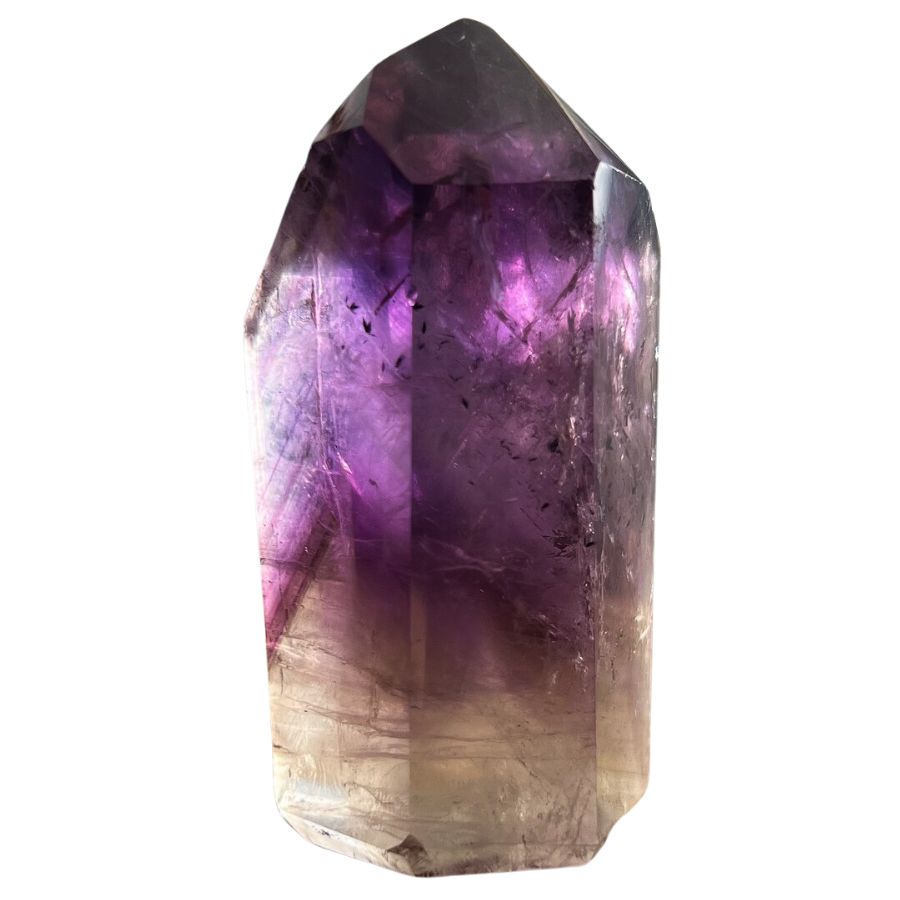
Phantom amethyst is a fascinating variety of amethyst. It stands out due to the presence of “phantoms” – ghost-like inclusions within its structure, which give it a distinct and layered look.
In phantom amethyst, one can observe a range of colors from deep purples to lighter hues, often appearing in layers or as phantom shapes within the crystal.
These color variations are typically due to trace amounts of iron and other minerals that get trapped during the crystal’s growth, influencing its final color.
Phantom amethyst provides a visual record of the crystal’s growth history. The crystal outlines and layers within the stone are formed by pauses in the crystal’s growth, offering a glimpse into geological processes over time.
Where you can find phantom amethyst
There are notable sources of phantom amethyst in Brazil, Madagascar, and the United States. In the United States, phantom amethyst is often discovered in states like Arizona, North Carolina, and Colorado.
Pink Amethyst
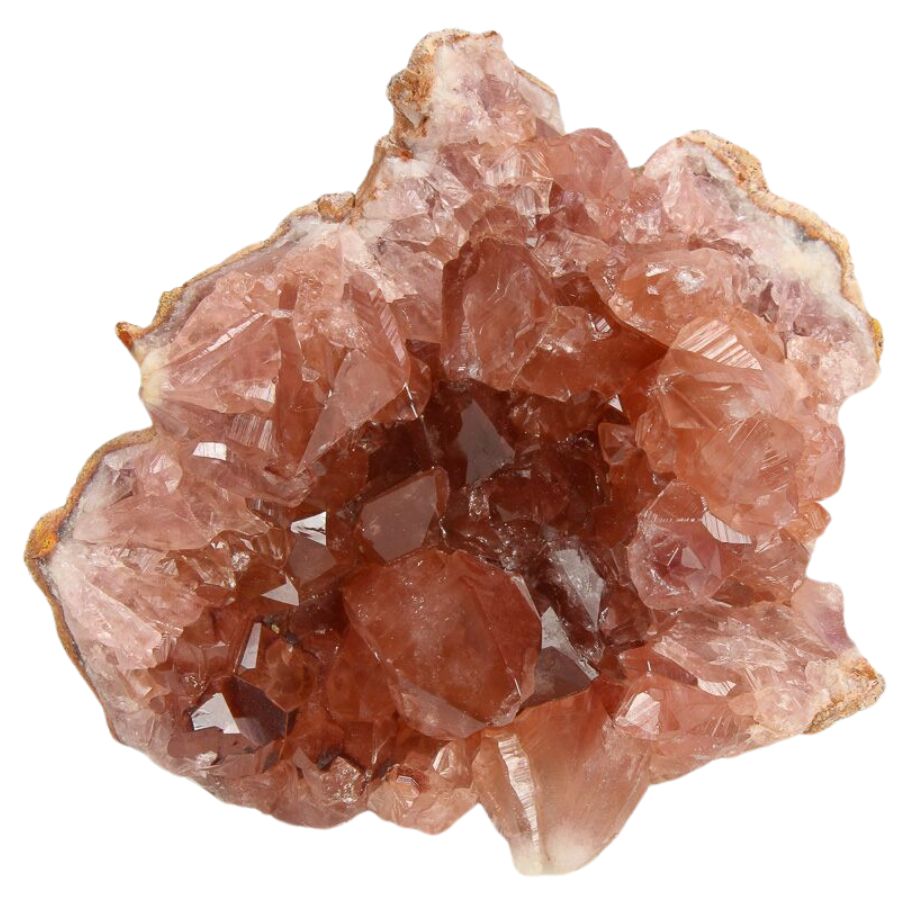
Pink amethyst is a unique and relatively rare variety of the common mineral amethyst. The presence of trace elements, particularly iron, contributes to its distinct pink hue.
The appearance of pink amethyst ranges from a delicate, light pink to a deeper, more vivid pink.
This variation in color is largely due to the concentration and distribution of iron within the crystal, which affects how light interacts with the mineral.
Pink amethyst is its often found in geodes or clusters, where multiple crystals grow together in a captivating display.
Amethyst Geodes
Amethyst geodes are fascinating natural formations, with traces of iron giving them their famous purple color. These geodes form in volcanic rocks and are essentially hollow, lined with amethyst crystals.
A key feature of amethyst geodes is their crystal-lined cavity, which creates a stunning natural display. When you look inside an amethyst geode, you’ll see a range of purple hues, from light lavender to deep violet.
The color variation is due to the amount of iron and the specific conditions under which the crystals formed, such as temperature and the presence of other trace elements.
Geodes can vary greatly in size, from small enough to fit in your hand to large enough to stand in, and each one is unique in its crystal formation and color pattern.
Where you can find amethyst geodes
Amethyst geodes are commonly found in Brazil and Uruguay. In the United States, they can also be found in places like Arizona and Oregon.
Cactus Amethyst
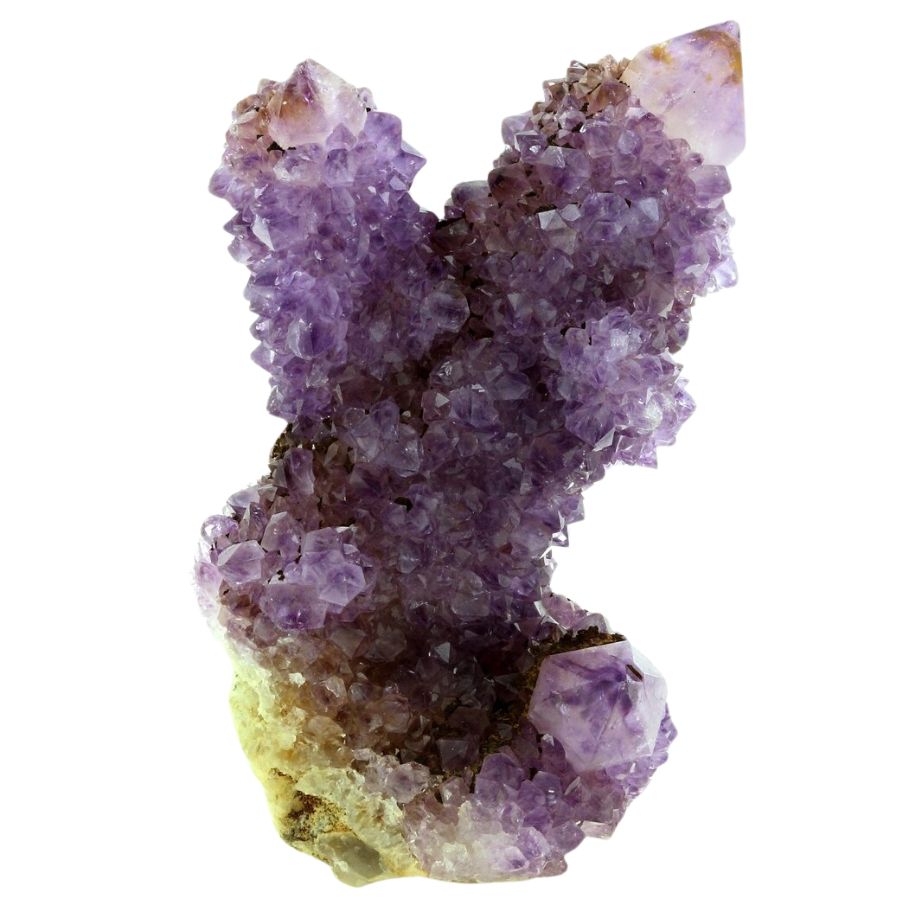
Cactus amethyst is also known as spirit quartz. Its unique structure is enriched with additional minerals, which contribute to its distinctive appearance.
This type of amethyst is characterized by a central quartz crystal covered in smaller crystal growths, giving it a spiky, cactus-like appearance.
The color ranges from pale lilac to deep purple, with the variations largely influenced by the amount of iron and other trace elements within the crystals.
A notable feature of cactus amethyst is the way the smaller crystals radiate outward from the central crystal.
This formation not only creates a stunning visual effect but also makes each piece of cactus amethyst a unique and fascinating specimen.
Regarding the price of amethyst, it can vary significantly based on the size, quality, and depth of color. While smaller, less vibrant pieces are relatively affordable, larger specimens with deep, rich colors can be quite valuable.
Scepter Amethyst
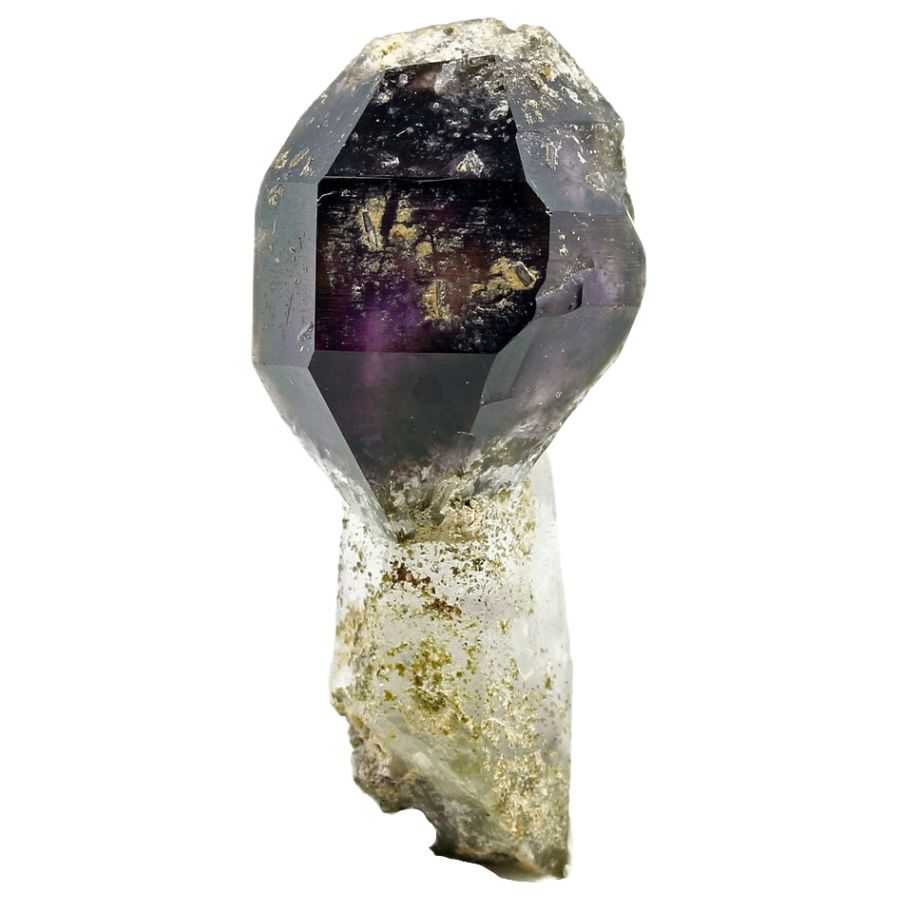
Scepter amethyst gets its name from its distinctive scepter-like formation, where a larger crystal cap sits atop a smaller crystal stem.
The color variations in scepter amethyst are influenced by the amount of iron and other trace elements within the crystal, coupled with the specific conditions under which it formed.
A key feature of scepter amethyst is its symbolic scepter shape, representing a crystal formation process where a second phase of growth occurs on an already-formed crystal base. This creates a striking and regal scepter-like appearance.
Where you can find scepter amethyst
Scepter amethyst can be found in several locations around the world, with notable spots including Brazil, Madagascar, and Zambia.
In the United States, areas like Washington State and North Carolina are also known for their scepter amethyst discoveries.
Smoky Amethyst
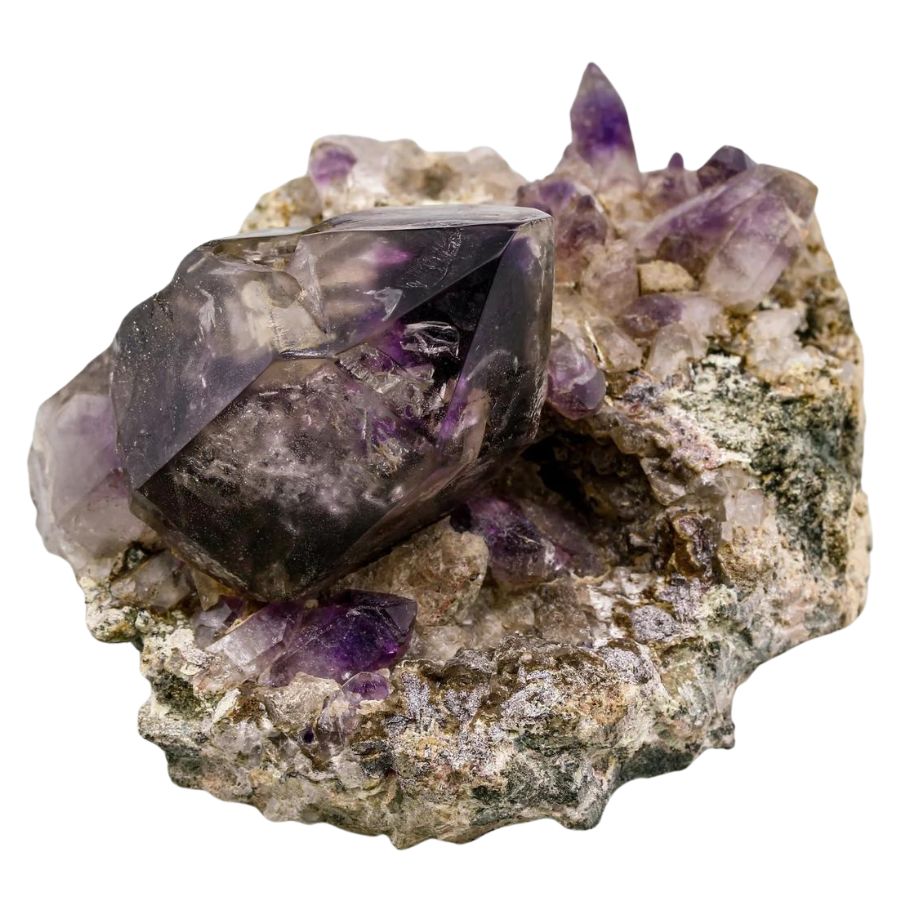
Smoky amethyst is a unique variation among amethyst types that combines features of both smoky quartz and amethyst. The presence of trace elements like iron and aluminum gives it its unique coloration.
This mineral exhibits a blend of smoky brown and purple hues, creating a captivating visual effect. This is due to natural irradiation and the varying amounts of impurities, which influence the depth and intensity of both the smoky and purple colors.
A notable feature of smoky amethyst is its dual-tone appearance, which is not commonly found in other quartz varieties.
Where you can find smoky amethyst
Smoky amethyst can be found in several countries, including Brazil. It’s also discovered in places like Africa and the United States.
- The deep experience and understanding of our team about the area
- Recommendations from local groups and clubs
- How easy it is to get the a particular location
- Safety and potential hazards when collecting
- Weighing private and public locations
- The ability for both experienced and novice amethyst enthusiasts to find great samples
With these factors in mind we’ve been able to put together a fantastic list that just about anyone can use!
The Best Spots To Find Amethyst in Missouri
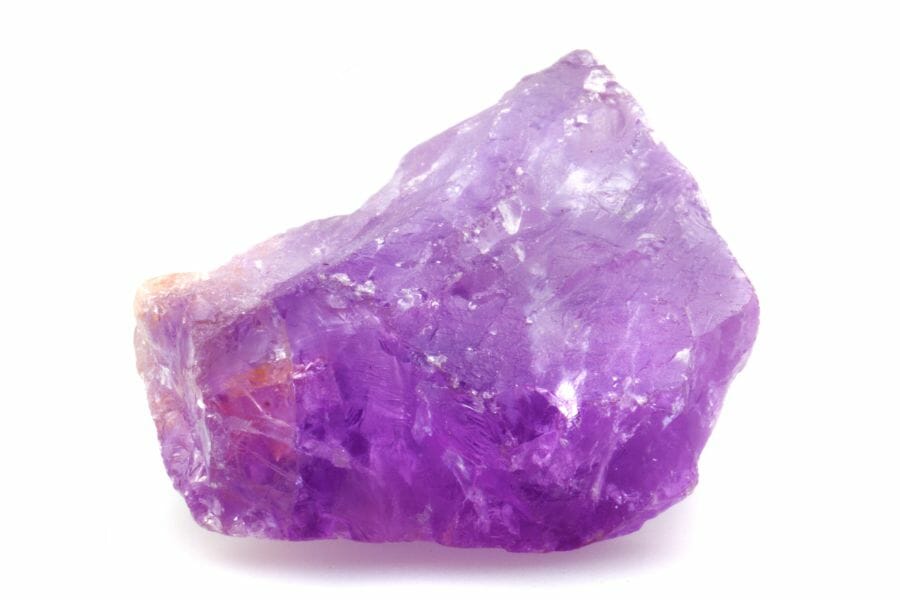
Here are our top selections for amethyst locations in Missouri. There are many great places to mine for gems in Missouri, but very few are great for seeking amethysts. Even though some of these locations are not that well-known, they’ve consistently given us fantastic options while searching.
Always Confirm Access and Collection Rules!
Before heading out to any of the locations on our list you need to confirm access requirements and collection rules for both public and private locations directly with the location. We haven’t personally verified every location and the access requirements and collection rules often change without notice.
Many of the locations we mention will not allow collecting but are still great places for those who love to find beautiful rocks and minerals in the wild without keeping them. We also can’t guarantee you will find anything in these locations since they are constantly changing.
Always get updated information directly from the source ahead of time to ensure responsible rockhounding. If you want even more current options it’s always a good idea to contact local rock and mineral clubs and groups
Huzzah Conservation Area

The Huzzah Conservation Area is a hidden gem that spans a whopping 6,225 acres, just begging for outdoor enthusiasts to explore. With its rolling hills, lush forests, and vibrant meadows, this scenic wonderland is a sight for sore eyes. It’s the bee’s knees for those looking to escape the hustle and bustle of city life.
The Huzzah Conservation Area is as varied as a patchwork quilt regarding its geography, terrain, and geology. With Huzzah Creek winding its way through the area, you’ll find a mix of deep valleys, narrow ridges, and gentle slopes. The land’s geology is chock-full of dolomite and sandstone, adding a touch of rugged charm.
With all this natural splendor, the Huzzah Conservation Area is truly a slice of heaven on Earth if you want to connect with Mother Nature and make memories that’ll last a lifetime.
Before you bring anything home, make sure you’ve read up on Missouri’s most recent collecting regulations.
Where we found amethyst in the Huzzah Conservation Area
We found amethysts in the area mines and mine dumps of the Huzzah Conservation Area along Highway 8 at Steelville. For more guidance, you can check out our guide on where to find amethyst around you.
If you want REAL results finding incredible rocks and minerals you need one of these 👇👇👇
Finding the coolest rocks in isn’t luck, it's knowing what to look for. Thousands of your fellow rock hunters are already carrying Rock Chasing field guides. Maybe it's time you joined the community.
Lightweight, mud-proof, and packed with clear photos, it’s become the go-to tool for anyone interested discovering what’s hidden under our red dirt and what they've already found.
Join them, and make your next rockhounding trip actually pay off.
What makes it different:
- 📍 Find and identify 140 incredible crystals, rocks, gemstones, minerals, and geodes across the USA
- 🚙 Field-tested across America's rivers, ranchlands, mountains, and roadcuts
- 📘 Heavy duty laminated pages resist dust, sweat, and water
- 🧠 Zero fluff — just clear visuals and straight-to-the-point info
- ⭐ Rated 4.8★ by real collectors who actually use it in the field
Ruepple Iron Mine
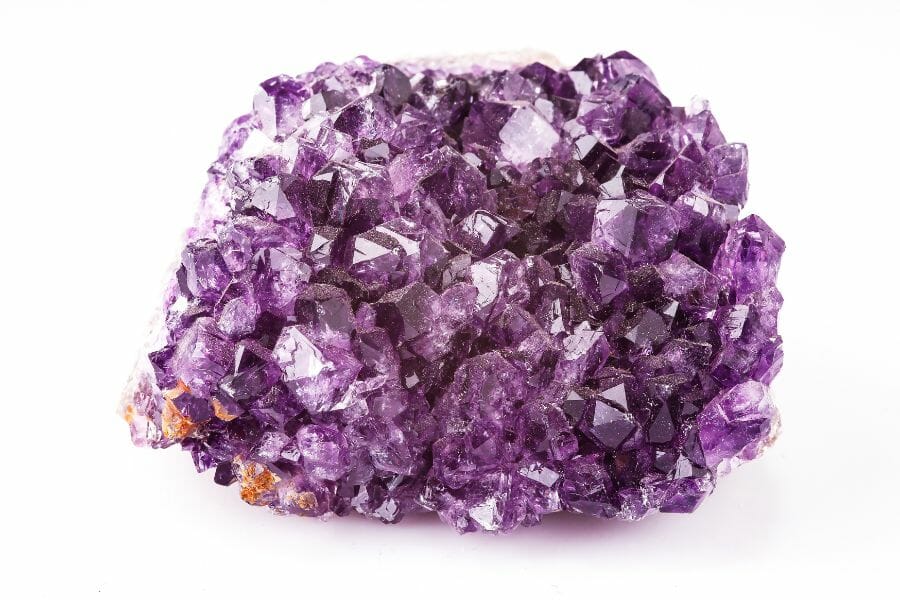
The Ruepple Iron Mine in Missouri is a lesser-known treasure trove steeped in history and natural wonder. Tucked away in the Show-Me State’s Iron County, this old mine’s got stories to tell and sights to see that’ll have you jawin’ with your pals for ages.
Geographically, Ruepple Iron Mine is snuggled among the rolling Ozark hills, offering visitors a chance to delve into a world filled with intriguing rock formations and a bygone era’s remnants. The terrain is a mixed bag of steep inclines, wooded slopes, and narrow ravines that’ll keep hikers on their toes. So, lace up those boots and be ready for a walk on the wild side!
Where we found amethyst in the Ruepple Iron Mine
Amethysts can be discovered in the Northwest area of Ruepple Iron Mine in Stanton. For more information about an amethyst’s value, check out this guide for rockhounds that love amethysts.
Buckland Mine
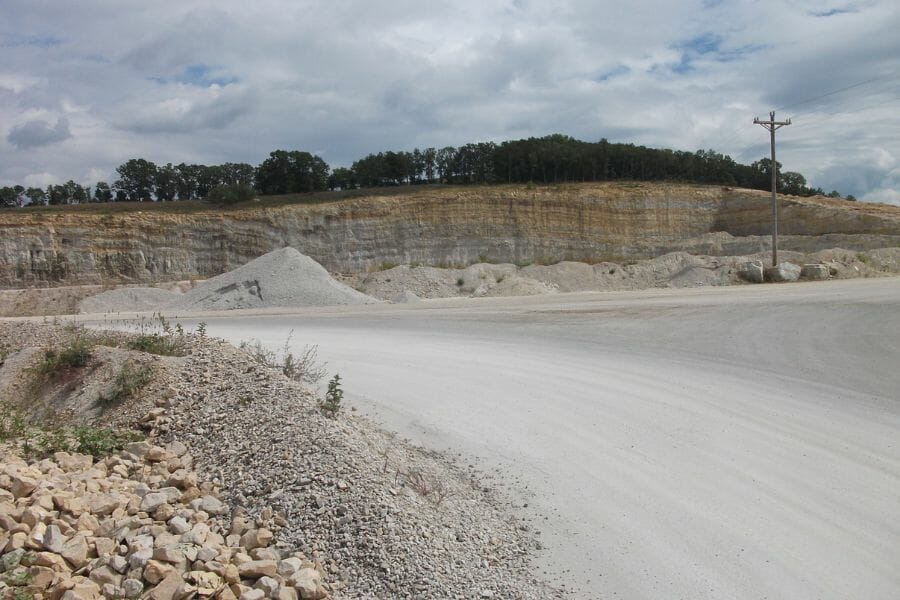
The Buckland Mine in Missouri is a rustic relic from yesteryear. This abandoned mine may not be the talk of the town, but it’s got an undeniable charm that’ll leave a lasting impression on anyone with a hankerin’ for history and geology.
Geographically speaking, the Buckland Mine sits smack dab in the middle of the Ozark Plateau, a region known for its rich mining heritage. The mine’s surroundings are a tapestry of densely wooded hills, rugged outcroppings, and the occasional babbling brook, creating a picturesque backdrop for a day of exploration.
Terrain-wise, you’re in for a rollercoaster ride of ups and downs, with steep inclines, craggy slopes, and twisting trails that’ll keep your heart racing and your eyes glued to the breathtaking views. It’s a spot where Mother Nature struts her stuff and leaves you wanting more.
Where we found amethyst in the Buckland Mine
You can locate amethysts in and around the Buckland Mine, a filled sink iron mine at Rolla.
Moselle Iron Mines
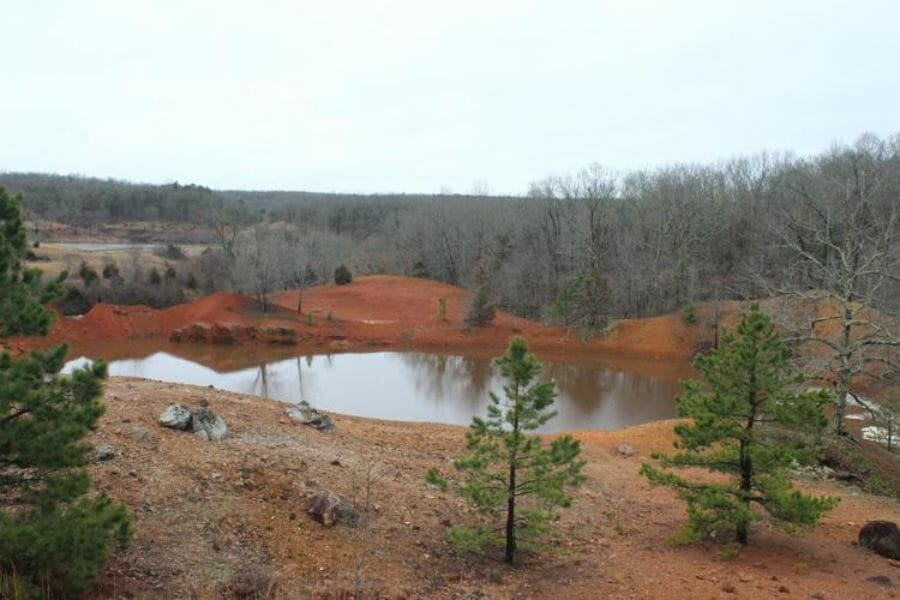
The Moselle Iron Mine in Missouri is tucked away in the heart of Franklin County. While it may not be the state’s crown jewel, it’s a piece of history worth a gander for folks with an itch for exploration and curiosity for geology.
Geographically, the Moselle Iron Mine sits pretty in the rolling hills of the Ozark Plateau. The region is a veritable treasure chest of mining history, and the Moselle Iron Mine is just one page in its storied past. The surroundings are a delightful concoction of dense forests, rocky outcrops, and trickling streams, all woven together to create a picture-perfect adventure.
The terrain at the Moselle Iron Mine is a mixed bag, with steep inclines, undulating slopes, and rugged trails. If you’re game for a bit of a challenge and eager to feast your eyes on some awe-inspiring vistas, then this is the place to be.
Where we found amethyst in the Moselle Iron Mine
Amethysts are located at the Moselle Iron Mine in the Southwest of Rolla.
Other Great Places To Mine For Amethyst in Missouri
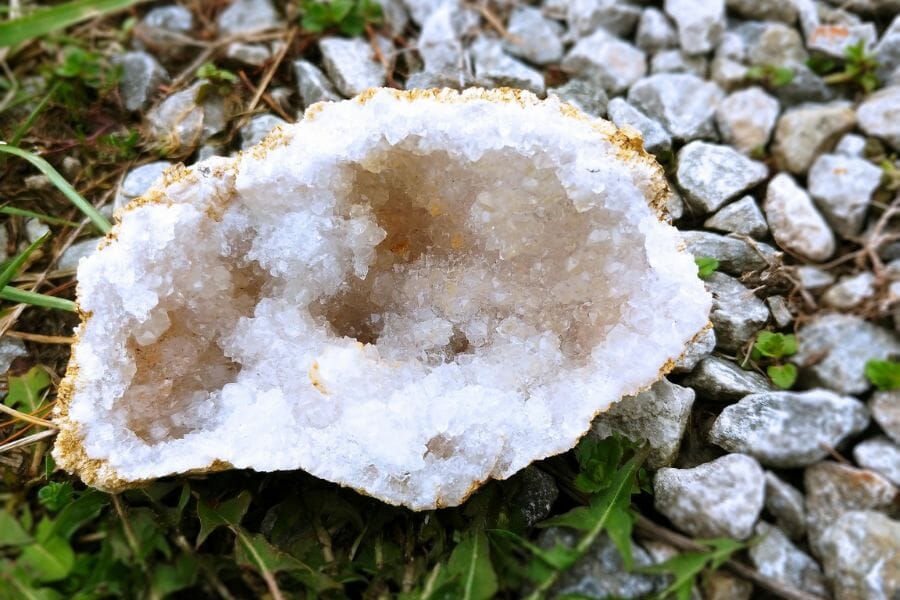
Our recommendations by county
Although we’ve included our top selections for amethyst locations in Missouri, there are still many more places we can recommend. Below, we’ve arranged them by the county to make things easier.
| County | Location |
| Crawford | Scotia Iron Bed Mines |
| Crawford | Cherry Valley Mines |
| Dent | Plank Mine |
| Franklin | Leslie Mine |
| Franklin | Pyrite Mine |
| Iron | Burt Bank |
| Osage | Meta Mine |
| Washington | Pea Ridge Mine |
Additional areas you can find amethyst
The area to hunt for amethysts in Missouri is vast, so we want to help you search. You should look into these key Missouri areas where amethysts are frequently found:
Mines and mine dumps
Mines and mine dumps serve as treasure troves for amethyst collectors, offering a wealth of hidden gems and geological marvels. These sites of mineral abundance have undergone significant excavation, making them ideal locations for individuals searching for precious amethyst finds.
Mines and mine dumps have become hotspots for amethyst enthusiasts because mining uncovers rocks and exposes pockets of crystalline formations. Often focused on extracting more valuable minerals, miners may overlook or discard rocks containing amethysts. This creates a unique opportunity for collectors with a keen eye to find valuable pieces.
Amethyst collectors can thoroughly examine mine dumps to find beautiful specimens left behind during mining operations. Patience and attention to detail can yield impressive amethyst clusters that captivate fellow enthusiasts.
Quarries
Quarries present excellent opportunities for amethyst collectors, as these sites reveal a wealth of geological formations and potential gem discoveries. As excavations occur within quarries, they expose layers of rock and unearth mineral deposits, creating an ideal environment for finding amethysts and other precious stones.
One of the reasons quarries are exceptional places for amethyst hunting is that their operations focus on extracting rock, gravel, or sand rather than explicitly targeting valuable minerals. As a result, beautiful amethyst specimens may be overlooked or discarded during the quarrying process. This scenario provides a unique chance for collectors to find amethyst treasures among the excavated material.
Rivers and riverbanks
Rivers and riverbanks provide a unique and rewarding environment for amethyst collectors, as these natural formations have the potential to reveal hidden gemstones and fascinating geological specimens. The continuous flow of water in rivers acts as a genuine sorting mechanism, unearthing and redistributing various stones along the riverbanks, increasing the chances of finding amethysts.
One reason rivers and riverbanks are excellent locations for discovering amethysts is the erosive power of water. As it moves through the landscape, water erodes surrounding rock and soil, freeing up mineral deposits, including amethysts. Over time, these gemstones are transported downstream and deposited along the riverbanks, where they are relatively easy to spot and collect.
Streams and creeks
Streams and creeks offer enticing prospects for amethyst collectors, as these waterways create an environment conducive to uncovering precious gemstones and intriguing geological samples. The movement of water within these smaller channels functions as a natural sorting process, dislodging and redistributing stones and increasing the likelihood of amethyst discoveries.
The primary reason streams and creeks are ideal for finding amethysts is the erosive action of water. Water gradually wears down the surrounding rock and soil as it courses through various landscapes, liberating mineral deposits, including amethysts. Over time, these valuable gemstones are carried downstream and deposited in streambeds and along creek banks, where collectors can spot and gather them more easily.
Common Amethyst-Hunting Questions
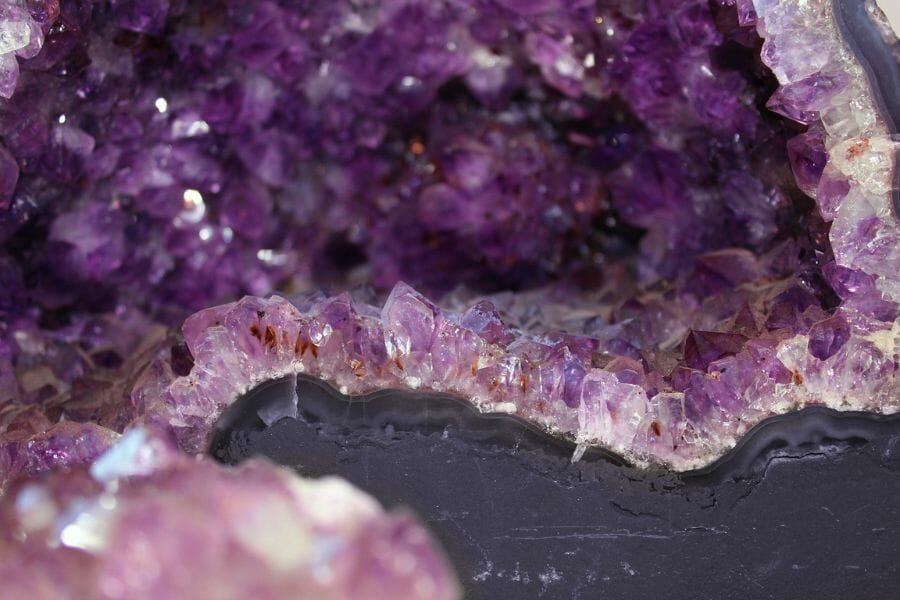
It’s essential to answer specific often-asked questions concerning amethysts from Missouri, such as the following:
Where can you find amethyst geodes in Missouri?
Missouri, unfortunately, lacks amethyst geodes naturally, but there are a few rock shops nearby where you might be able to find them and other jewels. These shops are listed below.
Is it illegal to collect amethyst in Missouri?
As long as you follow local laws, collecting amethysts is legal in Missouri. Be sure you abide by applicable local regulations if you’re on government land. If you’re on private property, be sure that you have permission.
The Best Places To Buy Amethyst In Missouri
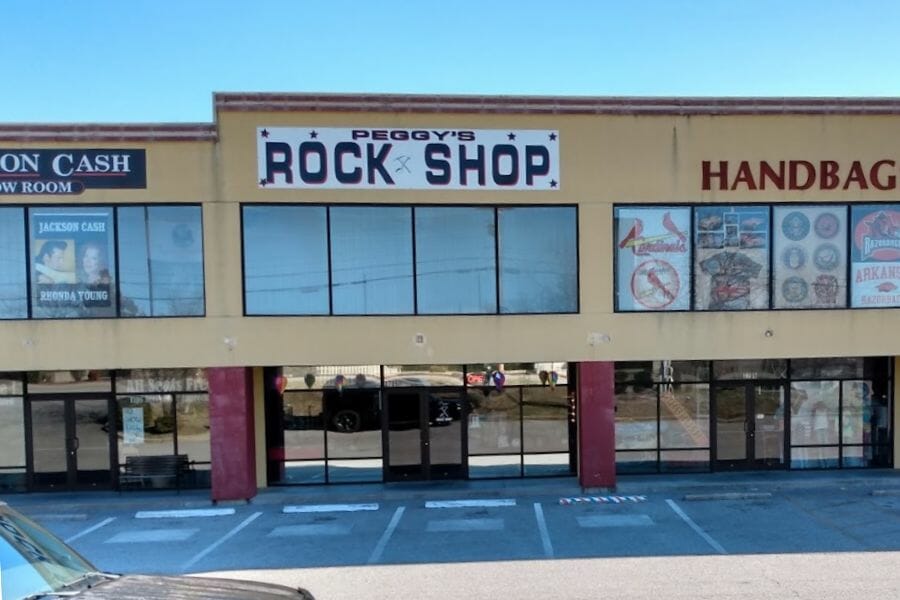
Not everyone enjoys spending hours wandering around in the wilderness looking for amethysts. Sometimes all you want is something attractive and easy to get for your collection or workplace. Here’s a list of rock shops where you can purchase amethyst crystals without doing too much work.
- Peggy’s Rock Shop – 3705 State Hwy 76, Branson, MO 65616
- Prospector’s Crystals, Rocks, and Gift Shop – 1640 Gravois Rd, High Ridge, MO 63049
- Sheffler Rock Shop – 26880 Topanga Canyon Blvd, Kahoka, MO 63445
- STL Rocks – 2003 Cherokee St, St. Louis, MO 63118
- Vulcan’s Forge – 3936 Broadway Blvd, Kansas City, MO 64111
Additional places to find amethysts in nearby states
When you’ve visited all the places listed above, you may use the list of guides we’ve gathered below to discover even more amethysts in surrounding states:
If you have any recommendations for our list, please leave a comment below!



